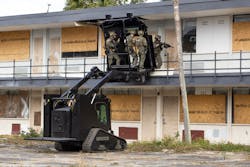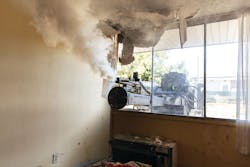SWAT teams are constantly trying to stay ahead of the game when it comes to new technology and equipment that can get the job done more efficiently while keeping its members safe. Since it first went into production about 15 years ago, The Rook from Ring Power Tactical Solutions has become a vital tool law enforcement agencies have turned to.
The Rook is an armored critical incident vehicle that allows SWAT teams to gain access to areas previously not accessible. It is custom-designed and fabricated from a Cat® chassis and features rubber tracks, dual joystick controls, cameras, gun ports, rear and front lights, an enclosed cab with air conditioning/heat and operator comfort seat, custom installed bullet-proof glass and NIJ Level IV armor cab reinforcement fabrication.
Alex Horcasitas, a former New Mexico State Police SWAT Commander who works with Ring Power, spoke to OFFICER Magazine about how The Rook helps tactical teams cope with manpower concerns and helps supplement the tools an agency already has at its disposal.
OFFICER Magazine March 2022 Digital Edition
Safety concerns
Before the New Mexico State Police purchased two of the machines about 10 years ago, Horcasitas said it would take three team members—one holding a shield, one holding a rifle or pistol and another with a throw phone—when approaching a barricade situation. “They all kind of scoot up to the house, which yes, they are protected, but windows can open. If someone needs to break the glass, a fourth member would need to be added. Once the phone would be put into the house, they would all have to walk back.”
Through the use of The Rook, the throw phone could be attached to the beaching ram and driven right up to the structure before driving off, all with one officer, fully protected. It could also be used to break a window with the ram that can extend another four feet and then The Rook’s public address system could be used to communicate with the suspect. “If the officer can get face-to-face, he can actually have the suspect just inside the house, right there talking to this guy over the intercom,” says Horcasitas. “It gives you an ability to approach and contact from an area you are protected. You are not jeopardizing officers and you are not forcing entry on someone and maybe forcing them to use aggression back on the officers.”Managing manpower
When Horcasitas was the commander, the New Mexico State Police SWAT team would receive somewhere in the ballpark of about a hundred activations per year—roughly two per week. The machine would be sent to each call but wouldn’t always be used because the incident would be resolved by the time it arrived. When it was used though, it proved to be a big help. The Rook can do things like move a vehicle out of a driveway to clear a view of the garage or front door. It can also easily remove burglar bars with its grappling claw instead of possibly putting officers in harm’s way to remove them.
“In the first scenario (with the throw phone) I had to give up three to four officers. Now, we don’t have to give up any,” says Horcasitas. “We trained all of our EOD guys to drive it so now we can communicate with them what we want but I’m not giving up any of SWAT guys for that. So it helps a lot with manpower.”
He says that The Rook became an invaluable piece of equipment and was well worth the price tag. “Think about it this way. I was a tactical team commander. I’m sending those guys up there to put a phone in with a shield. How much is each one of those lives worth? In money, you can’t put a money figure on it.” He adds that the cost of The Rook is really a “drop in the bucket” when it comes to money agencies spend. “You spend a lot of money on things, but the return you get on this is huge.”A supplemental tool
The Rook was used by the San Bernardino Police Department in 2015 to help take down Syed Rizwan Farook and Tashfeen Malik, the married couple who carried out a terrorist attack at the Inland Regional Center in California that left 14 people dead and 22 others injured. During a standoff on a highway following the attack, two Lenco BearCats pinned in the couple’s vehicle, allowing The Rook to approach.
Horcasitas began his career in law enforcement in the late ‘90s. “There was a time when we didn’t even use armored vehicles on call outs because we just didn’t have them,” he says. “All of the sudden we got the BearCats and then we think, ‘How did we do business without the BearCats?’ It’s so much a part of our inventory and our tactics. That’s exactly what this machine did.”
He stresses that The Rook isn’t meant to replace armored personnel carriers, but instead helps supplement what those vehicles already do. “A lot of officers will even say ‘We’ve got a Bearcat.’ Good, because that’s your stronghold, that’s your base of operations. This is your worker bee,” he says. “Before, if we had to break out a window or door or do anything else, guess what? ‘Everyone get off the BearCat,’ and we go do the work and then everyone jumps back on it again. It goes out there and takes care of business to the point where other agencies that have worked with us say ‘How did we do business before that?’ It’s a gamechanger.”





